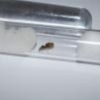I found the only barrier to work is fluon with olive oil underneath it (not above it). Olive oil works vastly better than vegetable oil. The trick is to heavily "paint" it on, then lightly dab/wipe it off with a towel to leave a thin, smooth surface of it left. I found nearly all ants (even Argentine ants and Solenopsis invicta) can't cross the olive oil when done this way. On top of that, the fluon adds another layer of escape proofing for ants. I heavily apply fluon (it can't be left on thick or it doesn't work), then dry it off a bit with a towel (not a paper napkin, but a dish towel works great) and this lets it be a thin, slippery surface for the ants.
I literally was able to leave the olive oil on for 6-7 months on my Pheidole megacephala colony I had, and it worked the entire time without it needing to be re-applied. But, humidity/temperature can change things, so your experience may be different than mine. I keep most of my ants in the garage where its always hot and dry in there.
Antscanada seems to have luck with vaseline judging by his videos, but he lives where its really humid all the time and that seems to work better for vaseline. I tried vaseline for Solenopsis invicta, and will NEVER use it again in Southern California. It was a complete disaster of ants escaping (they crossed it like it wasn't even there) and a long, multiple hours of a disaster of a cleanup.
With that said, not even fluon and olive oil works on Monomorium ergatogyna (pretty much exactly similar to Monomorium minimum over on the east coast). They are the best escape artists of any ants (better than Solenopsis molesta), and they are tiny. So, it all depends on the ant species as well.
A lot of it really comes down to trial and error, and different things work for different ants.
Edited by Vendayn, September 23 2016 - 7:27 PM.





















